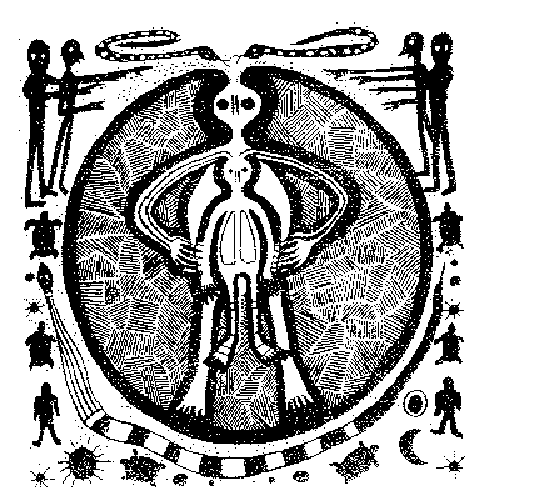 The term 'Ancient Astronauts' generally refers to extraterrestrials who
The term 'Ancient Astronauts' generally refers to extraterrestrials whocame to Earth and were in some way responsible for seeding the human race.
There are references to these entities in the bible, in ancient art and other texts. They are all linked with myths about creation found in all ancient civilizations.
As we search to find the truth behind the illusion, who created the human race, or biogenetic experiment, we look to those who came from the stars, ancient astronauts, creational gods, for our answers. All is theory, virtual reality, consciousness, and for the most part not provable, subject to the interpretation of the researcher or experiencer.
Most of us would love to find evidence of ancient astronauts, be visited by friendly aliens who could enlighten us to our true creational blueprint. Throughout the history of the human drama, we find all sorts of evidence that makes us think, believe, and quest for the greater truth. They are all just myths, legends, and theories...
Theories about Atlantis often link sightings of ancient astronauts to Atlantean space ships. This goes to the ancient gods called the Zep Tepi.
In China we find theories about an alien race called the Dropa who left behind fascinating discs.
The Popol Vuh, sacred to the Mayans, unequivocally states, "Men came from the stars, knowing everything, and they examined the four corners of the sky and the Earth's round surface."
Brazilian UFO researcher Jean Alencar has noted that the mythology of this country is replete with descriptions and statuettes of beings endowed with the power of flight. The legends of Brazilian natives, like those of other countries, detail experiences of gods or travelers from the sky who descended to earth when humans were little more that animals to instruct them in the arts of agriculture, astronomy, medicine, and other disciplines. Alencar points out one figure in particular, Bep-Kororoti, a space warrior worshipped by the tribes of the upper reaches of the Xing River. Not unlike the heroes of India's Mahabarata, Bep-Kororoti possessed a flying vehicle capable of destroying anything in its path. His aspect terrified the primitive natives, until he stepped out of his "raiment" and revealed himself to be fair-skinned, handsome, and kind. He amused the natives with his "magic" until he grew restless for his land in the sky and returned there.
The Chilam Balaam, is even more explicit and states "Beings descended from the sky in flying vessels...white men in flying rings, who can touch the sky."
There are indications that something very strange took place on our very own continent hundreds of thousands of years ago, before humans arrived on this continent (according to the canon of anthropology). Santa Maria Canyon holds evidence pointing toward the existence of a culture of intelligent beings who raised cattle, built weapons, and practiced funeral rites -- one million years ago. If we decide to stick with what academia has to say, in no way could these beings have been humans. Were they survivors of a Race of Aliens? This brings to mind theories of marooned spacemen, or colonists trying to tame a new planet? During the Prehistory Conference held during 1962 in Rome, Dr. W. Matthes presented the oldest carvings known to exist, created by a forgotten artist two hundred thousand years ago, when humans had allegedly just discovered the use of fire.
Discovered by the 19th century French explorer Henri Lhote, these figures were so unusual he dubbed them Martians, explaining their contour is simple, unartistic, and with rounded heads; their only detail is the double oval at the figure's center, which evokes the image we currently have of Martians.

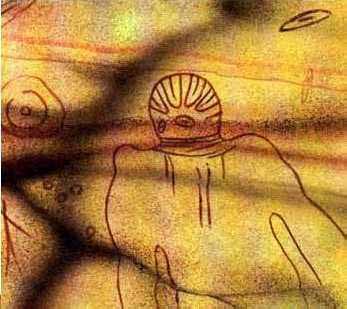
Sahara Desert

North Africa
Lhote's round-headed denizens of the Red Planet were depicted by the primitive cave artists as wearing suits strongly reminiscent of those worn by our own astronauts on the Moon, down to the detail of the boots. Several hundred such drawings exist, scattered over many miles of desert: strange helmeted and figures with antennae, often floating in weightlessness as if the artist had been able to witness one of our modern space walks. Other images are of a technological bent, showing what could be taken as solar panels, space stations, floating spheres containing humanoid figures. Unwilling to be caught up in the ancient astronaut craze, anthropologists have suggested that the Tassili "roundheads" are merely ceremonial dancers or priests wearing empty gourds over their heads. The problem with this rational approach is that the agricultural know-how and resources to grow pumpkins were nonexistent in North Africa at the time the Tassili drawings were created, and would probably not have been available for another thousand years.
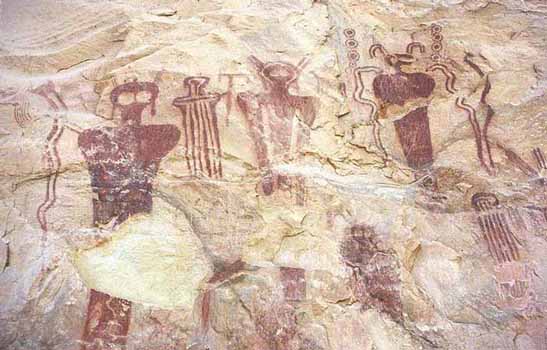 Sego Canyon, Utah, c. 5,500 BC
Sego Canyon, Utah, c. 5,500 BC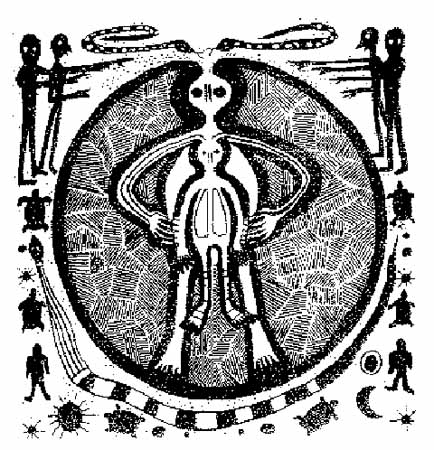
Val Comonica, Italy, c. 10,000 BC
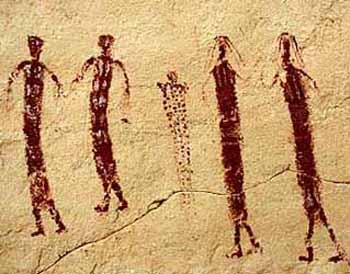
The examples of cave art found in the Spanish caverns of Ojo Guarea and Altamira, and the French ones at Lascaux and Font de Gaume, have proven that our distant ancestors were able to represent what they saw with a clarity and simplicity that is stunning to twentieth century eyes. This skill extends to depictions of things that anthropologists and archaeologists often find troublesome: equally faithful representations of domed objects, some of them in threes, others with legs or antennae.
Ancient astronauts have been described as bi-pedal entities often with beaks or wings, or reptilian looking, gray aliens, ethereal, or humanoid coming and going in space craft of some kind or moving in and out of our dimension. Different theories or stories of creation cite these entities, not unlike gods from heaven who many believe seeded the human experiment and will return one day. The feeling of a god returning to Earth, a savior, if you will, who restores balance, is a metaphor in the journey of the human experiment in linear time and emotion. All virtual created by consciousness. All are theories.
The Ojo Guarea complex, weaving its way for miles into the earth, poses an undecipherable riddle. In his book En Busca de la Historia Perdida (In Search of Forgotten History), Spanish author and filmmaker Juan G. Atienza states that some of the cave systems many entrances are considered "evil," and the local farmers will not till the soil near them nor even come close to them. Contained precisely within one of these "evil" points of access is an ancient petroglyph of what could only be, astounding though it might seem, a representation of the helicoidal structure of DNA.
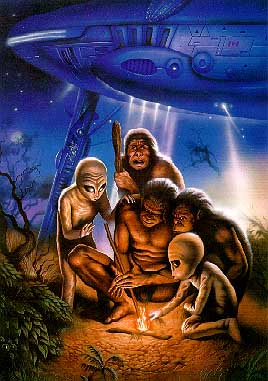
Source: Crystalinks

1 Comment:
we not find the proper information ab't ufos or other substances, today we saw something ab;t aliens on news channel by uk live telicast in a field, can u provide more information us
Post a Comment